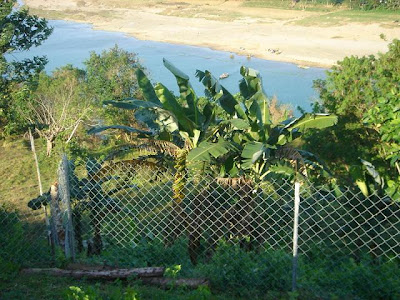Last May of 2009, I stayed at the farm on a short vacation. That gave me the chance to inspect some areas which I have not seen before.
Upon reaching the easternmost edge of the farm and admiring the view of the plains beyond and the river below, how I wished there was a direct access to the river, even if it means jumping down a cliff just to get there.

View of the river and the 'ledge' as seen from the edge of the farm.
Now there is this not so narrow strip of land, which I call the "ledge", that runs parallel to the river down below and the farm above. Problem is, this desirable piece of real estate belonged to two different owners, with an invisible boundary running somewhere in the middle.
We took chance and talked to the owner of the lot on the left of the boundary to see if he is amenable to sell a small parcel of his property. After agreeing on the right price, a piece of the "ledge" a few meters wide was ceded to the farm. This small piece of lot now sits in the middle of the two properties. And that was the highlight of my vacation!

The strip of lot outside the fence and down below used to belong to our neighbor. It is now part of the farm and leads down to the 'ledge'.
After enclosing the farm with a fence, the only way to get to the "ledge" is to build a ladder, create a stairway, or a climb down a rope. None of these implements are in place yet so getting down the ledge is a challenge. Jumping is not an option either since that would result to broken bones and severe bruises. Well, at least the farm is now connected to the river's edge.

Continuation of the picture above, now also part of the farm.
Not satisfied with this sliver of lot a few meters wide, I still wished we could have a bigger area. If only...
Then one day in October last year, after the fence has been installed, the previous owner of our piece of the "ledge" offered to sell the rest of his to us. Gladly and without hesitation, we took the offer. All of a sudden the area of our "ledge" got substantially bigger. Also, access got safer and easier since now we can hike down to it.

Continuation of the picture above, now part of the farm. The land from here down to the 'ledge' is now part of the farm.
So the next time you wish for something, remember the rest of the wise saying because...
...you might get it!
Now how I wish we could get the right side too...




















